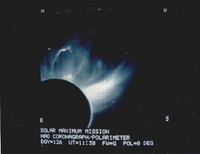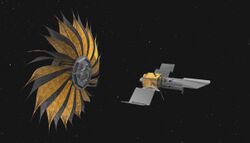Astronomy:Large UV Optical Infrared Surveyor
| Names | LUVOIR |
|---|---|
| Website | asd |
| Start of mission | |
| Launch date | 2035 (proposed) |
| Orbital parameters | |
| Reference system | Lagrange 2 point |
| Main | |
| Diameter | 8 m to 18 m |
| Wavelengths | UV, visible and infrared |
The Large UV Optical Infrared Surveyor (LUVOIR) is a multi-wavelength space observatory concept being developed by the Goddard Space Flight Center and proposed for the Decadal Survey Concept Study started in January 2016. The concept is based on a mirror from 8 m to 18 m in diameter,[1] and covering the ultraviolet, visible and infrared wavelengths. It would be a Large Strategic Science Mission and be up for selection sometime after 2020.[2]
LUVOIR is a set of goals and requirements for a space telescope, but is not a specific design. More concrete proposals have their own names, such as ATLAST and HDST. One of those will be selected to become LUVOIR.[3][4]
Overview
LUVOIR would be equipped with an internal coronagraph, and would have the option to make use of an external starshade. It would also have a range of high dynamic range sensors that work in the ultraviolet, visible and infrared wavelengths.[1][5]
In 2016, NASA began considering four different space telescopes for the Large Strategic Science Missions (formerly Flagship Program) mission;[2] they are the Habitable Exoplanet Imaging Mission (HabEx), Large UV Optical Infrared Surveyor (LUVOIR), Origins Space Telescope (OST), and Lynx X-ray Surveyor. In 2019 the four teams will turn their final reports over to the National Academy of Sciences, whose independent Decadal Survey committee advises NASA on which mission should take top priority. If funded, it would launch approximately in 2035,[2] with a heavy launch vehicle and it would likely be placed at the Sun–Earth Lagrange 2 point.[6]
Preliminary goals

Its four main goals are to investigate astrophysics, exoplanets, the cosmic origins and the Solar System.[5] LUVOIR would be able to analyze the structure and composition of exoplanets' surface, and image faint circumstellar disks to provide insights on how planets form. It would also detect biosignatures on distant exoplanets' atmospheres.[7] Atmospheric biosignatures of interest include CO2, CO, molecular oxygen (O2), ozone (O3), water (H2O), and methane (CH4).[8]
LUVOIR's multi-wavelength capability would help understanding how host star's UV radiation regulates the atmospheric photochemistry on habitable planets.
Preliminary characteristics
The concept is based on a mirror from 8 m to 18 m in diameter,[1] and sensors that cover wavelengths from 0.1 μm (far UV) to 5 μm (mid-infrared).[2][5] For satisfactory performance of its detector arrays, the lens and sensor system would have to be actively cooled to between 270–295 K (−3–22 °C)[8] while other systems will have to be warmed. In addition of imaging at various wavelengths, it will also have spectroscopic capabilities.[9]
LUVOIR would be equipped with an internal coronagraph,[10] a disk that allows the diffracted starlight to be suppressed so that orbiting exoplanets can be directly observed, and would have the option to make use of an external starshade.[11] Starshades are a relatively new idea for providing the extreme high-contrast needed for exoplanet direct observations. A starshade is an independent spacecraft flying in formation with the telescope while it casts a shadow on the telescope. A starshade blocks the unwanted bright light from an exoplanet host star before it enters the telescope, while allowing light from nearby planets to pass nearly unattenuated.[11]
References
- ↑ 1.0 1.1 1.2 LUVOIR Large Ultraviolet/Optical/Infrared Surveyor (PDF) 2017. Goddard Space Flight Center, NASA. 2017.
- ↑ 2.0 2.1 2.2 2.3 Scoles, Sarah (30 March 2016). "NASA Considers Its Next Flagship Space Telescope". Scientific American. https://www.scientificamerican.com/article/nasa-considers-its-next-flagship-space-telescope/. Retrieved 15 August 2017.
- ↑ "Extension of ATLAST/LUVOIR's Capabilities to 5 Microns, or Beyond". 14 May 2016. arXiv:1605.04367 [astro-ph.IM].
ATLAST and HDST can be thought of as possible implementations of LUVOIR.
- ↑ Cofield, Calla (1 February 2016). "NASA's Next Great Space Telescope: The Quest Begins". Space.com. https://www.space.com/31778-nasa-next-great-space-telescope.html. "One of the most recent such proposals has been named the "High Definition Space Telescope," (HDST), but the general concept is called LUVOIR (Large Ultraviolet Visible Infrared)."
- ↑ 5.0 5.1 5.2 "LUVOIR – Large UV/Optical/Infrared Surveyor". NASA. http://asd.gsfc.nasa.gov/luvoir/. Retrieved 15 August 2017.
- ↑ Getting to Orbit: Launch Vehicles - LUVOIR Tech Note Series. Norman Rioux, 5 August 2016. Goddard Space Flight Center, NASA.
- ↑ Rauscher, Bernard J.; Canavan, Edgar R.; Moseley, Samuel H.; Sadleir, John E.; Stevenson, Thomas (October–December 2016). "Detectors and cooling technology for direct spectroscopic biosignature characterization". J. Astron. Telesc. Instrum. Syst. 2 (4): 041212. doi:10.1117/1.JATIS.2.4.041212. Bibcode: 2016JATIS...2d1212R. https://www.spiedigitallibrary.org/journals/Journal-of-Astronomical-Telescopes-Instruments-and-Systems/volume-2/issue-04/041212/Detectors-and-cooling-technology-for-direct-spectroscopic-biosignature-characterization/10.1117/1.JATIS.2.4.041212.pdf.
- ↑ 8.0 8.1 Werner, Michael (5 August 2016). The Long Wavelength Limit of LUVOIR (PDF) (Technical report). LUVOIR Tech Note Series. Goddard Space Flight Center, NASA.
- ↑ Ultraviolet Detectors for Cosmic Origins and Exoplanet Science with LUVOIR — LUVOIR Tech Note Series (PDF). Kevin France and David Schiminovich. 5 August 2016. Goddard Space Flight Center, NASA.
- ↑ Starlight Suppression with Coronagraphs - LUVOIR Tech Note Series. (PDF) Stuart Shaklan. Goddard Space Flight Center, NASA. August 5, 2016.
- ↑ 11.0 11.1 High-Contrast Imaging with Starshades (PDF) Aki Roberge. Goddard Space Flight Center, NASA. 2017.
See also
- Advanced Technology Large-Aperture Space Telescope (ATLAST), one possible LUVOIR implementation
- High-Definition Space Telescope (HDST), another possible implementation
External links
- The Large UV Optical Infrared Surveyor (LUVOIR) aka Hubble 2.0 Summary of interview with Brad Peterson & NASA video




